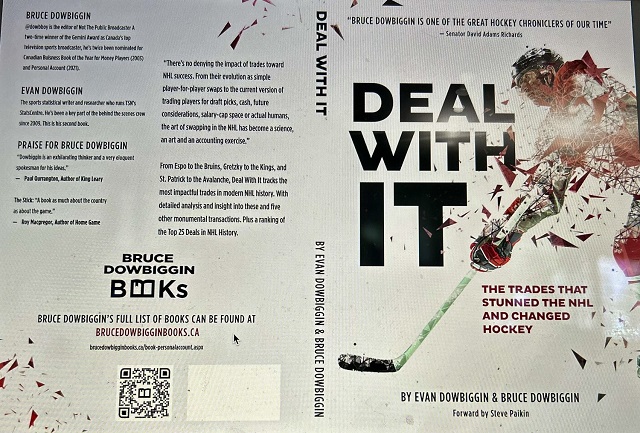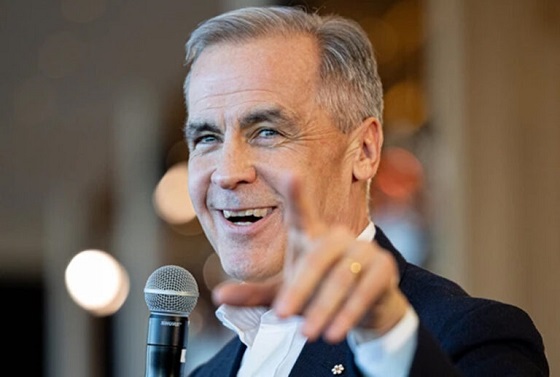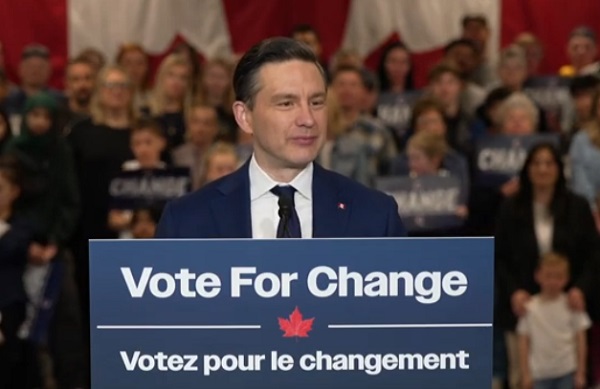Bruce Dowbiggin
Deal With It: When St. Patrick Talked His Way Out Of Montreal

Coming soon, our latest book “Deal With It: The Trades That Stunned The NHL And Changed Hockey”. With my son Evan, we look back to Espo to the Bruins (1967), Gretzky to the Kings (1988) , and St. Patrick to the Avalanche (1995), Deal With It tracks the back story behind the most impactful trades in modern NHL history. With detailed analysis and keen insight into these and five other monumental transactions, Deal With It recalls the moments when history was changed. Plus a ranking of the Top 25 Deals in NHL History.
One of the most memorable occurred 24 years ago, on December 6, 1995: Patrick Roy and Mike Keane from the Montreal Canadiens to the Colorado Avalanche for Jocelyn Thibault, Martin Rucinsky and Andrei Kovalenko. Trading, arguably, the greatest goalie the Canadiens history was the culmination of organizational dysfunction from which it has yet to recover. It begins with the hiring of former Habs Mario Tremblay and Rejean Houle when the Canadiens stumbled entering the 1994-1995 season. It started off well. Then on a November night in Montreal…
“With the team cooling off from their torrid start under (Mario) Tremblay, the Habs were at home for a Saturday night affair hosting a powerful Red Wings team on its way to breaking the NHL single-season wins record set by the 1976-77 Montreal team (62 to that club’s 60). With the closing of the Forum, the arena Roy had once dominated, Patrick’s dominance had become less-than-surefire. (He came in that night at 238-80-34 all-time at the Forum.) All that rich history didn’t help Roy that particular night and before a national TV audience the wheels came off for hundreds of thousands to witness.
Earlier in the day, Roy had had an impromptu breakfast at Moe’s Diner in Montreal with Detroit goalie Mike Vernon, who’d himself been forced out of Calgary after winning a Cup. Roy described his predicament. “It might be time for you to ask for a trade,” Vernon suggested to him. Fast forward to the notorious game. Getting bludgeoned by the Wings attack, Roy had given up nine goals before the game hit its halfway mark. Getting mock cheers for one of his few saves on the night- prompted a seething Roy replied with mock acknowledgement to the crowd. Clearly overwhelmed, Roy was kept in the nets as Tremblay let his star goalie get roasted by Scotty Bowman, who enjoyed getting revenge on his former player Tremblay for some remarks he’d made about Bowman’s coaching style.
Finally hooked after the ninth marker, Roy glared menacingly at his coach as he walked by on the bench. Stopping to take care of more business, he walked back across and, face-to-face, told a distressed-looking Corey that he had just played his last game with the Canadiens. As Roy walked past Tremblay on his way to the end of the bench, Roy and Tremblay glared eye-to-eye. Roy told him in French, “You understand?” This very public moment overshadowed what remains the worst home loss in the club’s storied history, an 11-1 spanking from Detroit. TV highlights that night across North America showed the stare-down.“The whole city was talking about it,” recalled Montreal native Eric Engels. “The team had suspended Roy and said they were going to trade him, and I just remember saying to the bus driver that they didn’t have to go this way, that they could salvage the situation.”
The following days saw the controversy erupt even further. Just months after plucking Houle and Tremblay from outside the organization, Corey sided with his inexperienced newbies and told Roy he would be getting dealt even when Roy apologized for his spat and vowed to mend fences. Typical of the climate at the time for even superior players who “disrespected” the organization, Roy was persona non grata in a matter of days. In his book, Serge Savard: Forever Canadien”, Savard explained the inevitability of the deal: “Patrick had become too important in the club. He took up too much space in the dressing room, had too much influence on the coach. Over the previous years, I had to handle him with kid gloves. I still had the same admiration for him as I did when we won the Stanley Cup in 1986 and 1993, where he played a determining role. But a change had become necessary. The team revolved around him too much. For the good of everyone, he needed a change of scenery.”
Team captain Mike Keane didn’t help lower the temperature at the Forum by claiming the man who wore the “C” with the Canadiens didn’t necessarily need to speak French and that he wouldn’t be bothering to learn it because the dressing room mostly communicated in English (true even in the most predominately French-based Habs teams such as the 1993 Cup winner that boasted no less than dozen Quebecois). Both Keane and Roy would go on the trading block together, joining similarly exiled pieces like Chris Chelios and Guy Carbonneau (the captain of the ’93 Cup winner, dealt after 1993-94 to the Blues for Jim Montgomery, after flashing the middle finger to a photographer who had eavesdropped on him playing a round of golf). Carbonneau’s successor at captain, Kirk Muller— an Ontario boy through and through— expressed how honoured and proud he was to wear the fabled letter patch. But he, too, would find himself gone to the Islanders partway through 1994-95. In other words, almost no one was sacred in Ron Corey’s world. Only four days after his dressing-down of the team president and head coach, Roy was notified by Houle that he had been traded.
Just like that, Montreal had parted with its franchise goalie as if it were still the “Original Six” days and players that got in management’s crosshairs were expendable. How traumatic was the deal for the rookie GM Houle? He’ll never tell. “And that is what I intend to do forever so that I don’t have to look back at a time that was difficult for me.” As for Roy, his take was “It was clear from the organization that they had made their decision. I said, ‘Okay, I’ll accept my mistake.’ I agree I was the one who made that thing happen on that Saturday, and both parties agreed it was in the best interests of us that we go different directions. I understand that you can’t put ten years aside and give it a little tap and it’s all gone. I lived through lots of good things in Montreal, but, again, it’s a turn I accept.”
Bruce Dowbiggin @dowbboy is the editor of Not The Public Broadcaster A two-time winner of the Gemini Award as Canada’s top television sports broadcaster, he’s a regular contributor to Sirius XM Canada Talks Ch. 167. Inexact Science: The Six Most Compelling Draft Years In NHL History, his new book with his son Evan, was voted the seventh-best professional hockey book of all time by bookauthority.org . His 2004 book Money Players was voted sixth best on the same list, and is available via brucedowbigginbooks.ca.
2025 Federal Election
Trump Has Driven Canadians Crazy. This Is How Crazy.

“Liberalism is based on one central desire: to look cool in front of others in order to get love. Preaching tolerance makes you look cooler than saying something like, ‘Please lower my taxes.’”— Greg Gutfeld
Having lived 25 years in the West after 45+ years in the East we can now generalize on the state of the nation. In the West the attitude is to grasp the future. Not fear it. Accept risk and loss as partners. In the East the default sentiment is to fear the future. Think of every reason why it might fail.
Quebec fears losing its culture. Ontario fears losing its power. The Maritimes fear losing equalization money. Hence Danielle Smith and Doug Ford as contrasting symbols of leadership. But 2025 is something new.
Donald Trump’s unsparing assessments of modern Canada— “We don’t really want Canada to make cars for us, to put it bluntly. We want to make our own cars — and we’re now equipped to do that”— have exposed this fissure in the country. Is it him or is it us? Families and friendships are being destroyed by the response. As Canadians head to the polls it’s obvious that persuasion is not going to apply in this climate. Arguments are falling on deaf ears.
With a large segment of the population doubling down on a failed past it’s time to make an I-told-you list of the implications of letting Donald Trump scare you into voting for a re-run of the Liberal Party. Double this dread if the Liberals get a majority.
To those Boomers living off the equity in their paid-off homes, get ready to be taxed on the appreciation in your homes. While you cherish your stand-alone private residence, get ready for the neighbours to sell out to someone who will erect a six-storey, 36-unit condo on the property right next to you because “sustainable growth”.
Got someone under 50 in your life? The Carney Reflex is bad news. Adding debt and embracing the destructive Trudeau social positions is a killer for those looking to commit to a future in Canada. Should Poilievre lose the election and his seat expect a brain drain away from the failed state. And the prosperity they create to vacate as well.
To those who cherish free expression expect hate-speech laws like those in UK where police will arrest you in your homes for social-media comment hostile to the ruling Party. And even if you shut down your posts watch out for neighbours who will exploit snitch lines to get you out of the hood.

Buttressing the party line, Carney will restore CBC’s funding— and then some— to drown out any social media pointing out the indelicate facts about his Trudeau-sourced cabinet members. He’ll also keep propping up failing private media, preventing them from bankruptcy so long as they spew DEI 24/7/365.
For those who cried fake tears over the Rez school graves scandal, watch Liberals pass legislation that gives unelected leaders of indigenous communities veto power over development of Crown Lands. Expect the Liberals, trying to maintain the NDP vote they assumed this year, to resurrect the “genocide” label against Canadians and fly flags at half mast again.

If you hoped to get to the bottom of innumerable scandals on the Liberals watch— ranging from eco-theft to China infiltration— Carney will put the clamps on any inquiry. The steady stream of Canada’s wealth to third-world kleptocrats will become a flood.
To those who thought Mark Carney had cancelled the consumer carbon tax, prepare yourself to find out that he just reduced it and will come back full-throttle as soon as the Conservatives fire Pierre Poilievre. While Carney plays the Housing Saviour he will also use the Carbon Tax to make concrete and fertilizer way more expensive, thus boosting the cost of the 50,000 homes he will never build and farm land will go fallow.
With CPC out of the way, expect no significant moves to end Canada as the money laundering capital of the world, the global fentanyl hub, international home to organized crime heads and a reported 1 in 7,800 residents as members of organized crime.
Batten down the hatches as Carney’s Liberals use their mandate to maintain the immigration deluge, thereby destroying Canada’s support systems for health, infrastructure and burying western values.

Get set for all your fossil-fuelled vehicles and heating to be taxed into oblivion with the proceeds going to more bike lanes, clogged public transportation on unreliable electric vehicles. Expect listening to obnoxious Quebec politicians brag on their “clean” hydro power.
Speaking of vehicles, the Sheila Copps set mocked Poilievre’s vision of urban hell where cops tell you not to protect your goods in a home smash-and-grab or car-jacking. With police ceding the field to organized gangs it will be open season as courts and the Liberals abandon the middle class to obey DEI imperatives.
And most of all, welcome to a full-fledged constitutional crisis sparked by Alberta and Quebec that will make the 1980s federal/ provincial rumbles look like Sunday school. Both will seek referendums from their voters on sovereignty or some equivalent. As we suggested last month the best case could be the UK model of regional parliaments. Saskatchewan and Alberta could join with indigenous communities to demand a regional say on how their revenues are distributed. Expect purchased media to humble brag for the ruling Liberals.

The worst outcome of Carney as PM is Alberta gaining independence or, gasp, joining America. Because Quebec can never get a better deal outside Canada expect them to use any momentum on sovereignty to extort further concessions from what’s left of Canada.
But why believe us? According to the report released in early 2025 by Policy Horizons Canada — the Government of Canada’s in-house think tank— upward social mobility could become a relic of the past, with wealth and opportunity increasingly inherited rather than earned. Their scenario outlines a country where rising inequality, inaccessible housing, and a broken promise of meritocracy leave younger generations disillusioned, disconnected, and doubtful that effort alone can improve their lives.
So with scant days left in the campaign the problem for Conservatives is not that the Liberal base believes Carney and their heroes. They’ve seen enough to know Mr. Burns is a fraud. But with their #TDS the true believers will never admit to backing a lying, losing hype train. That would be like death to them. So they’re closing their eyes and hoping it will all be over soon and they can go back to Mr. Dressup. Just know their kids will never forgive them.
Bruce Dowbiggin @dowbboy is the editor of Not The Public Broadcaster A two-time winner of the Gemini Award as Canada’s top television sports broadcaster. His new book Deal With It: The Trades That Stunned The NHL And Changed Hockey is now available on Amazon. Inexact Science: The Six Most Compelling Draft Years In NHL History, his previous book with his son Evan, was voted the seventh-best professional hockey book of all time by bookauthority.org. You can see all his books at brucedowbigginbooks.ca.
2025 Federal Election
How Canada’s Mainstream Media Lost the Public Trust

Breaking: CBC News admits that host Rosemary Barton was wrong on April 16 when she said “remains of indigenous children” have been discovered.
Call it the Panic Election. From The Handmaid’s Tale to Quebec alienation to plastic straws, the dynamic is citizens being stampeded in a brief six weeks by Big Brother. (There’s no Big Sister. That would mess with the narrative.) Prompting Covid Part Deux from the Laurentian media scolds.
Nowhere is this panic more keen than among aging Boomers who’ve pronounced themselves willing to ignore a decade of Justin Trudeau’s clumsy, unethical and sometimes criminal behaviour in the wake of Big Bad Trump. Even the threat of losing the country’s AAA credit rating can’t sway them from full-throated panic about being the 51st state.
The 51st state gambit is the window dressing. The real Trump panic is over him exposing the inadequacies of a Canadian society penetrated by China, dominated by globalist fanatics and more indebted every day. Specifically, Trump labelled Canadians defence dead-beats and entitled snobs who’d be crazy not to join the U.S. The insulting Trump framing has been a lifeline to those most recently in office— Liberals— to point at the Big Bad Wolf outside the door rather than the Frozen Venezuela inside its walls.
Integral to this panic is the role of Canada’s legacy media, a self-serving caste saved from bankruptcy (for now) by generous wads of public money. The 416/613 bubble ponies operate as if it were still 1985, not 2025. They’ve managed to preserve their status while society changed around them. For instance, CBC’s flagship At Issue panel features three people from Toronto and a fourth from Montreal.
It has worked perfectly in Boomer Canada. Until this past week, when the media guardians finally lost the plot. The combination of TV panel hubris and the incompetence of the Elections Commission exposed an industry more interesting in protecting its own turf than protecting the truth.
The meltdown was the notion that conservative social media— with its intrusive reporters and tabloid tactics— had no place in their sandbox. This hissy fit came after Wednesday’s French debate. Members of Rebel News, True North and other outfits dominated the party leaders’ scrums with obtrusive questions about Mark Carney’s opinions on same-sex sports and what constitutes a woman— questions the French moderator had neglected to ask.

For legacy reporters and hosts who take it as given that they be allowed the front pew this was an affront to their status. As purveyors of the one true political religion the talking heads on CBC, CTV and Global began speaking of “so-called journalists” and “far-right” intruders elbowing into their territory. Their resentment was all-consuming.
This resentment spilled into Debate Night Two when a shouting match ensued in the press room. A CBC source claimed (incorrectly) that Rebel Media leader Ezra Levant had been barred from the press room. A writer from the Hill Times screamed at members of their raucous rivals. The carefully chose panelists suggested that these outfits were funded by dark right-wing sources.
Before the debate had ended Elections Commission organizers— reportedly goaded by the Liberals— called off the post-debate scrum citing “safety” issues that seemingly included a Rebel reporter conducting a hostile walking interview with a furious Liberal official. This unleashed another torrent of Media Party vitriol about its position as the keepers of Canadian journalism.

In a show of irony, these complaints about right-wing misinformation came from people whose livelihood is dependent on Liberal slush funds or whose organizations have accepted government funds to stave off bankruptcy or whose union is an active shill for non-Conservative parties. The conflicts are never mentioned in the unctuous festival of privilege.
What makes this rearguard action against new media risible was the 2024 U.S. election where Donald Trump acknowledged the new day and rode the support of non-traditional media back to the presidency. His shunning of the legacy networks and hallowed print brands heralded a new reality in American elections. Poilievre has struggled to find this community in Canada, but for those with eyes it remains the future of disseminating political thought.
A perfect example of alternative media scooping the tenured mob on Parliament Hill has been the sterling work on China by Sam Cooper, a former Global employee who has independently demonstrated the ties between Chinese criminal gangs and the Canadian political structure going back to the 1980s. Working with others outside the grid he’s shown the scandal of a Liberal candidate urging Chinese Canadian voters to reap a bounty for turning his Conservative opponent to the Chinese Communist Party. A disgrace that Carney has forgiven.
Predictably Cooper’s work and the independent story by two retired RCMP investigators who implicated nine Liberal cabinet members in compliance with the Chinese communists has gotten the ‘tish-tish” from the Laurentian elites. Like the Democrats who buried the Hunter Biden laptop story to save his father in the dying days of the 2020 U.S. election the poodle media hope to delay the truths about China long enough to get the compliant Carney over the finish line.
For contrast to how it was— and could be— one only had to witness the moderator performance of journalist Steve Paikin of TVO. Largely unknown outside Ontario, Paikin overcame the skepticism of Westerners by playing it straight down the middle. Such was his honest-broker performance that Poilievre was heard telling him after the debate that he had no idea how Paikin might vote. (Ed. note: Paikin is a former colleague and longtime friend.) In other words, it’s still possible.
It’s a cliché that this election is a hinge point for Canada. Will it face itself in the mirror or indulge in more denialism about its true self? No wonder unaffiliated journalists joke that their stories today will be the lead on mainstream media in three months. Carney has promised to continue bribing the mainstream media, but their day is done. It’s simply a matter of fixing a date for the next panic.
Bruce Dowbiggin @dowbboy is the editor of Not The Public Broadcaster A two-time winner of the Gemini Award as Canada’s top television sports broadcaster. His new book Deal With It: The Trades That Stunned The NHL And Changed Hockey is now available on Amazon. Inexact Science: The Six Most Compelling Draft Years In NHL History, his previous book with his son Evan, was voted the seventh-best professional hockey book of all time by bookauthority.org. You can see all his books at brucedowbigginbooks.ca.
-

 2025 Federal Election2 days ago
2025 Federal Election2 days agoTrump Has Driven Canadians Crazy. This Is How Crazy.
-

 2025 Federal Election2 days ago
2025 Federal Election2 days agoCarney’s Hidden Climate Finance Agenda
-

 2025 Federal Election2 days ago
2025 Federal Election2 days agoThe Anhui Convergence: Chinese United Front Network Surfaces in Australian and Canadian Elections
-

 2025 Federal Election2 days ago
2025 Federal Election2 days agoStudy links B.C.’s drug policies to more overdoses, but researchers urge caution
-

 Automotive1 day ago
Automotive1 day agoHyundai moves SUV production to U.S.
-

 Entertainment1 day ago
Entertainment1 day agoPedro Pascal launches attack on J.K. Rowling over biological sex views
-

 2025 Federal Election2 days ago
2025 Federal Election2 days agoWhen it comes to pipelines, Carney’s words flow both ways
-

 2025 Federal Election21 hours ago
2025 Federal Election21 hours agoAs PM Poilievre would cancel summer holidays for MP’s so Ottawa can finally get back to work



